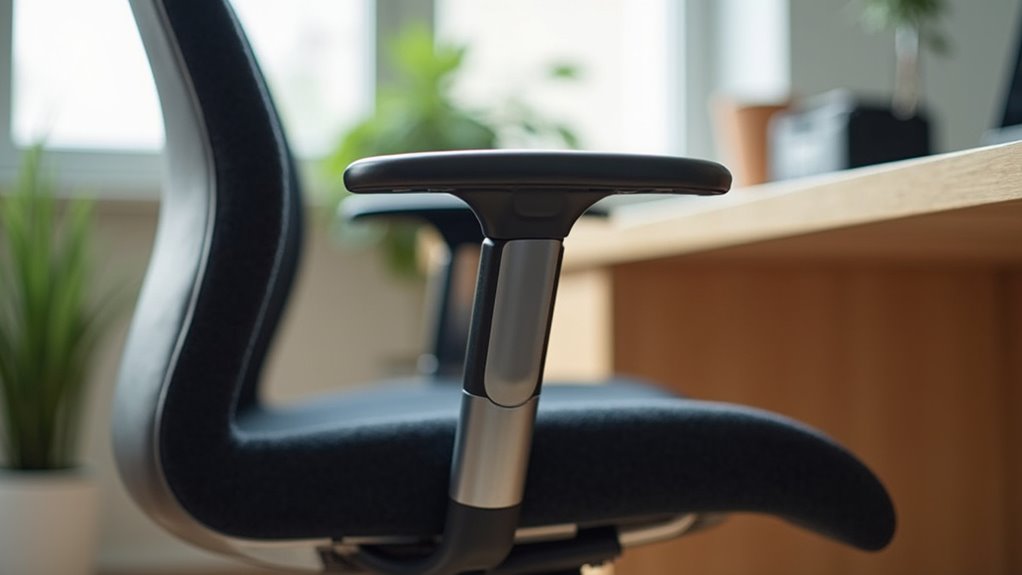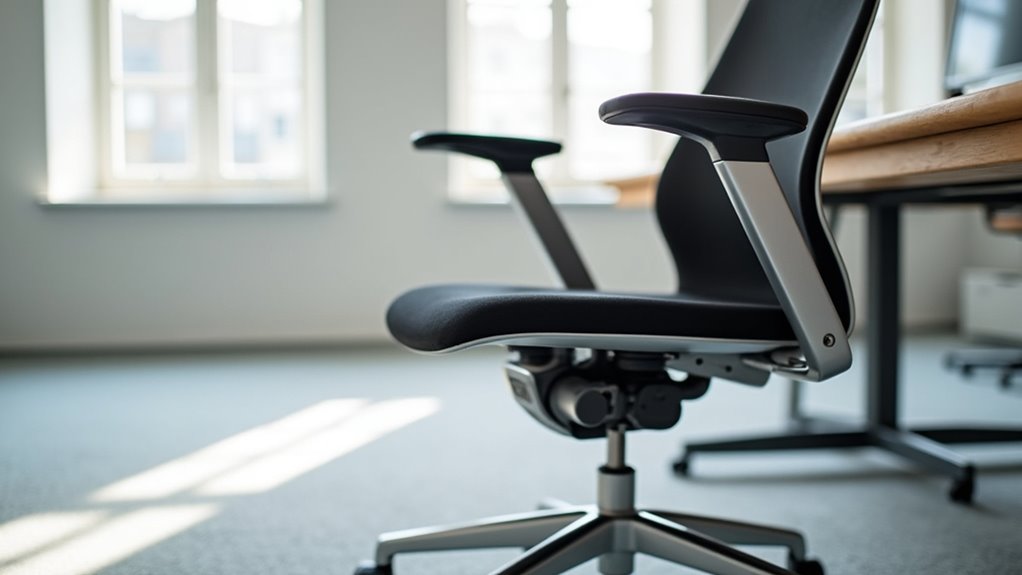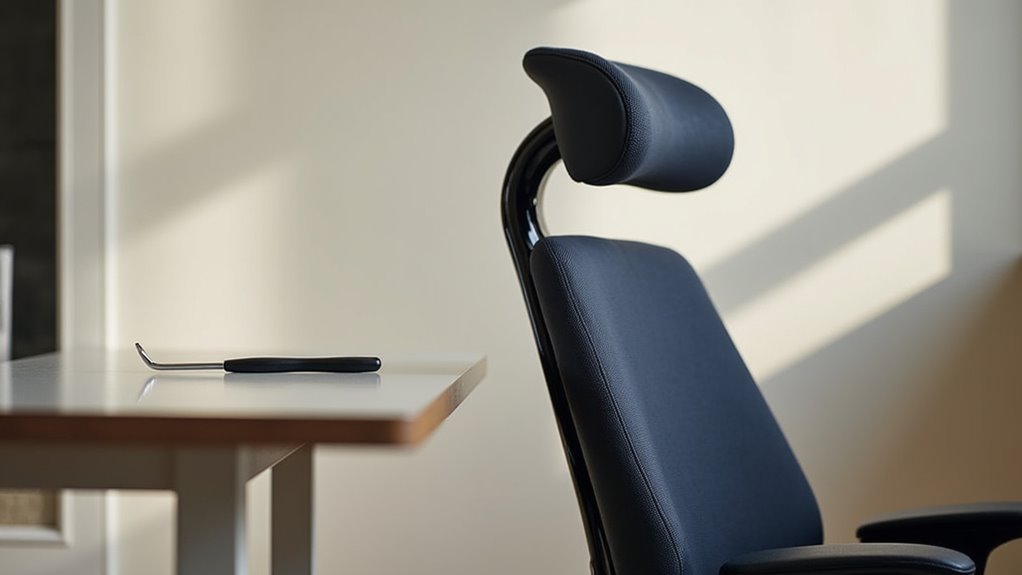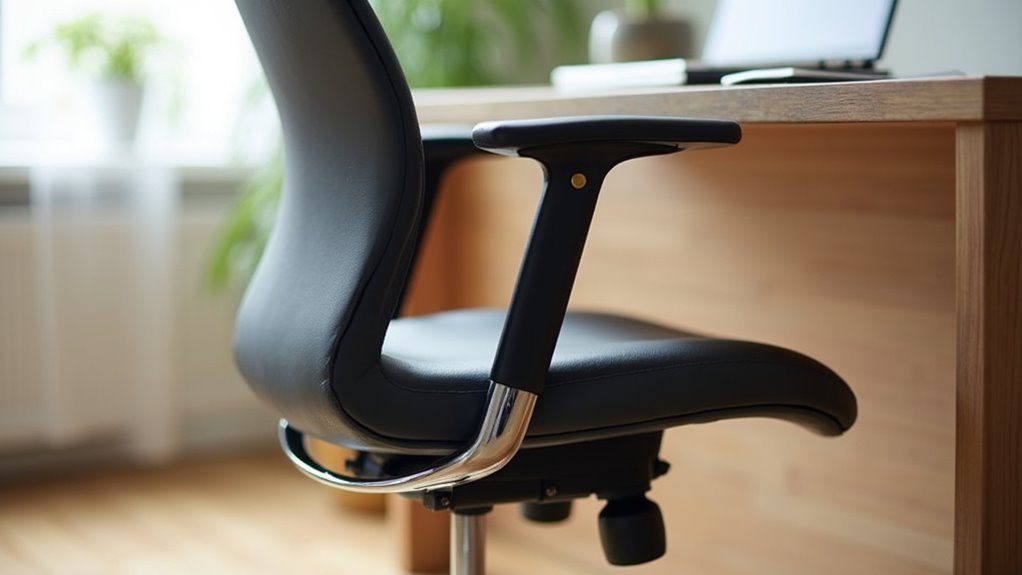How to Adjust a Desk Chair
This post contains affiliate links. As an Amazon Associate, we earn from qualifying purchases.
To adjust your desk chair for optimal comfort and support, begin by setting the seat height so your feet rest flat on the floor. Then, check the seat depth, ensuring there are two fingers’ worth of space behind your knees. Adjust the backrest to provide lower back support and position the armrests so your elbows are comfortably at a 90-degree angle. For those interested in additional tips, including headrest adjustments, further details will follow.
Essential Facts in 30 Seconds
- Adjust seat height for flat feet and 90-degree knee bend.
- Maintain a 2-3 finger gap behind knees for seat depth.
- Align backrest and lumbar support with spine’s natural curve.
- Position armrests for 90-degree elbow bend without shoulder lift.
- Set headrest to touch back of head for proper posture support.
Seat Height Adjustment
Adjust your desk chair’s height for comfort. Find the height adjustment lever on the right side under the seat. To raise the seat, stand up and pull the lever. To lower it, sit down and pull the lever again. Your chair will sink down easily.
Make sure your feet are flat on the floor. Your thighs should be parallel to the ground. This position helps keep your body happy and healthy. Proper height adjustment is essential for overall comfort and can significantly affect your productivity. If your desk is too high, use a footrest. This keeps your feet supported and avoids dangling. Proper chair height also encourages better posture, which can further enhance your comfort while seated.
A comfy seat height can help prevent back pain. It also helps you stay focused on your work. Adjusting the height correctly can prevent pressure on thighs, which is necessary for maintaining good circulation.
Take the time to adjust your chair. Enjoy being comfortable while you sit!
Seat Depth Adjustment

Getting the right seat depth is key for your comfort. Adjust it so your thighs are well-supported. Aim for a gap of two to three fingers between the seat edge and the back of your knees. This helps you avoid the edge of the seat. Sitting like that can lead to fatigue and bad posture. No one wants that! Proper seat depth contributes to overall comfort and improves your sitting experience. Additionally, proper sitting posture is essential for enhancing well-being and productivity while working at your desk. Checking proper positioning can help ensure you achieve optimal comfort and support with the right adjustments. Furthermore, ensuring that your chair has lumbar support is crucial for maintaining spine alignment and reducing discomfort over time. Enjoy better comfort and support with the right adjustments.
Importance of Proper Depth
Adjusting the seat depth of your desk chair is very important. It greatly affects your comfort while working or studying. A proper seat depth matches your thigh length. This provides full thigh support. It helps prevent pressure points under your thighs and knees.
A chair that’s too deep can make you slouch. Slouching hurts your posture. With the right seat depth, you can sit back fully. This gives you good lumbar support and keeps your spine happy. Proper seat depth ensures adequate thigh support, which is essential for long periods of sitting. Additionally, maintaining an ideal knee angle helps to further enhance your sitting posture. Proper posture can also reduce discomfort and improve overall well-being during long hours of sitting. Furthermore, proper adjustments to your chair can lead to better productivity and focus.
Comfort is key. A well-adjusted seat can boost your focus. You’ll stay on task without distractions.
Make sure to set your seat depth correctly for the best experience.
Adjusting for Comfort
Finding the right seat depth makes a big difference in your comfort. It’s especially important during long hours at your desk.
To adjust your chair, sit back and look for the lever or button on the side. Slide the seat pan forward or back until there’s about a 2-finger gap between the edge and the back of your knees. This design helps avoid pressure on your thighs. Better blood circulation means more comfort. Proper height aids blood circulation and can significantly enhance your overall comfort level. Additionally, ensure that the seat depth allows you to maintain a 90-degree angle at your knees for optimal support. Adjusting the seat depth correctly is crucial for enhancing thigh support and overall comfort.
If the chair feels hard or uncomfortable, add a cushion for extra support. Adjust your chair while sitting to find the best fit. Check your seat depth often, especially when your tasks change. Stay comfy and feel like a rockstar at work!
Backrest Adjustment
Getting the backrest just right is important. It should support your lower back well. Adjust the lumbar support to match your natural curve. Think of it as a cozy blanket for your spine. A well-designed ergonomic chair can significantly enhance your sitting experience. Proper lumbar support reduces strain and helps maintain healthy posture.
Make sure to check the backrest angle too. A slight recline can feel relaxing while you work. It’s like a mini-vacation. For better focus, keep it upright.
Comfort is key for long hours at your desk. A good backrest helps you stay productive and feel great. Proper sitting techniques can alleviate strain on the lower back, enhancing your overall comfort while seated.
Take the time to find the perfect setting for your needs. Your body will thank you!
Lumbar Support Importance
Your desk chair’s lumbar support acts like a superhero for your back! It keeps your spine’s natural curve. This helps reduce strain and pain. Good lumbar support stops you from slouching or hunching. This is a big win for your posture. An ergonomic chair with proper positioning not only supports your back but also encourages a balanced posture. Proper lumbar support is essential for reducing strain on the back, as it aligns your spine correctly.
Adjustable lumbar support is even better. It lets you change the height and depth. This means a perfect fit for your body. You can sit longer without feeling uncomfortable. This boosts your focus and productivity.
Proper ergonomic seating matters. It’s not just about comfort. It’s also about keeping your spine healthy. A proper chair selection can significantly enhance your overall well-being. Show some love to your chair’s lumbar support. Your back will thank you. Say goodbye to backaches while you work!
Backrest Angle Adjustment
Adjust the backrest angle of your desk chair for better comfort and support. A good angle can help your back feel great and make sitting easier. Here’s how to do it:
- Sit straight with your back against the chair.
- Locate the lever or knob on the side or back.
- Lean back and set the angle between 100 and 110 degrees.
Lock it in once you find the right position. This small recline supports your spine and reduces pressure. Adjusting the height keeps you comfortable while you work. A well-adjusted backrest helps you stay focused and energized.
Don’t hesitate to make adjustments throughout the day. Enjoy better sitting!
Armrest Adjustment

Getting your armrests right can greatly improve your comfort while working. Start by sitting up straight with your feet flat on the floor. Adjust the height of your armrests so your elbows bend at a 90-degree angle. This helps with proper posture. If the armrests are too high, your shoulders will be tense. Too low, and you may lean forward, which isn’t good.
Next, check the width of the armrests. Use a knob or lever to move them closer or farther apart. Your arms should rest naturally. Keep your shoulders relaxed.
Finally, adjust the depth by sliding the armrests forward or backward. They should support your arms without making your wrists strain.
Once you adjust everything, lock it in place. Now, you’re ready to work comfortably. Armrests can truly make a difference in your day!
Headrest Adjustment

A comfy headrest can greatly improve your comfort while working at your desk. Follow these tips for perfect headrest adjustment and better ergonomic support:
- Set the height so it touches the back of your head, not your neck.
- Tilt it slightly backward for a more relaxed feel when leaning back.
- Sit up straight and keep your shoulders relaxed as you adjust.
To adjust the headrest, use gentle pressure to raise or lower it. It should support your head without pushing it forward or backward. A well-positioned headrest keeps your neck comfortable.
If you feel any discomfort, make more adjustments.
Check your headrest often, especially after long hours or when changing tasks. A well-adjusted chair really makes a difference. Your neck will appreciate it!
Additional Considerations

Getting your headrest right is just the start.
Let’s make your desk chair even more comfy and supportive.
Check your seat height. Your feet should rest flat on the floor. Your knees need to bend at about 90 degrees.
Can’t reach the floor? Use an adjustable footrest.
Next, think about the seat pan depth. There should be a small gap, about 2 inches, between the seat edge and your calves.
This helps keep your blood flowing.
Now, adjust the armrests. They should support your elbows without lifting your shoulders.
Finally, pay attention to the chair materials. Some fabrics breathe better, while others feel softer.
These small changes can greatly improve your comfort. Enjoy your adjustments! Correct sitting posture is essential for preventing discomfort during long study sessions.
Your chair can be your best friend during long study sessions.
Frequently Asked Questions
How Often Should I Adjust My Desk Chair Settings?
Check your chair settings every 3 to 6 months. Adjust them when you feel discomfort. Regularly changing your chair settings helps improve comfort. It also gives you ergonomic support. This support is important as your body and tasks change. A well-adjusted chair can help you focus better and reduce strain. Remember, comfort is key to a productive day. Don’t wait too long to make adjustments. Stay comfortable and stay productive.
Can I Use My Chair Without a Headrest?
About 10–12 pounds of head weight can strain your neck. Using your chair without a headrest can help with comfort. A good position supports your back and neck. If you choose not to use a headrest, find other ways to support your neck. Adjust your chair height and back angle for better posture. Remember, comfort is key for long hours of sitting. Make sure your workspace is set up right. This helps you stay focused and avoid discomfort.
What if My Chair Doesn’T Have Adjustable Features?
A chair without adjustable features can still be comfortable. Try using lumbar cushions to support your lower back. Footrests can help keep your feet flat and reduce strain. You might also explore other seating options, like stability balls or ergonomic chairs. Small changes can make a big difference. Focus on your posture. Sit up straight and keep your feet on the ground. These tips can help improve your comfort while you work.
How Do I Maintain My Desk Chair for Longevity?
To keep your desk chair lasting longer, follow some simple steps. Clean it regularly with the right techniques. Use a soft cloth and mild cleaner for the fabric and plastic parts. For metal parts, a gentle polish will help.
Lubricate any moving parts. Use a silicone spray or a light oil. This keeps the wheels rolling smoothly and the chair adjusting easily.
Check for worn-out parts. Replace any damaged wheels, casters, or armrests. This will improve comfort and support.
Are There Specific Adjustments for Tall or Short Individuals?
Height matters for comfort. Tall people need higher seats and better back support. This helps them sit comfortably without strain. Short people require lower seats. They should adjust armrests and footrests. This keeps their arms and legs in a good position. Ergonomics play a big role in comfort at work or home. Good adjustments lead to better posture and less fatigue. Everyone deserves a chair that fits their height. Comfort boosts productivity. Make these changes for a healthier, happier workspace.
Conclusion
Adjusting your desk chair improves comfort and helps you focus. A well-fitted chair can boost your productivity. Spend a few minutes changing the seat height and armrests. This simple act can make a big difference. A good chair supports your back and keeps you happy. Try it out for yourself. Your back will appreciate it!
